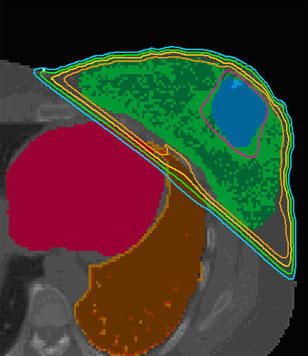Single-Topic News Release
Carefully Mixed Radiation Cocktail Reduces Collateral Damage In Breast Cancer Patients
A carefully determined mixture of electron and x-ray beams precisely treated breast tumors while significantly reducing collateral skin damage in 78 patients, researchers will report on August 1 at the annual meeting of the American Association of Physicists in Medicine in Orlando. The key to choosing the right mixture of beams, as well as their individual properties, was a sophisticated computer approach developed by medical physicists Jinsheng Li, Ph.D. (Jinsheng.Li@fccc.edu) and Chang-Ming Ma, Ph.D. of Fox Chase Cancer Center in Philadelphia.

Targeting of a breast tumor (depicted in blue). Courtesy Jinsheng Li.
In treating shallow tumors such as those that occur in the breast, physicians have been turning to mixed-beam radiation therapy (MBRT), which employs separate beams of electrons and photons (x-rays). The two types of radiation complement one another, as electrons generally travel to shallow depths while the x-rays can penetrate to deeper parts of the tumor as needed.
However, each beam interacts in complex ways with its environment, making their exact path to the tumor region hard to predict. Nonetheless, physicists can calculate the probability for a given beam to follow a desired trajectory.
Therefore, Li and Ma use computers to simulate billions of trips of each beam to the unique landscape of each tumor. Gathering the statistics from these billions of trials, they determine the best beam properties and mixtures.
The computer simulations helped oncologists send accurately targeted doses for 78 breast cancer patients receiving "hypofractionated" treatments, in which the patients received fewer, but more potent, doses of radiation. The beams delivered all the radiation within a small margin of the tumor's edge, dramatically reducing radiation damage to surrounding healthy tissue. The researchers expect their approach to provide benefits for reducing collateral damage in the treatment of shallow tumors in the breast, chest wall, and head-and-neck region.
Associated Meeting Papers:
TU-D-224A-6, "Advanced Mixed Beam Therapy Using MERT and IMRT," Tuesday, August 1, 2006, 2:30 PM, Room 224 A. Click Here for Technical Abstract
WE-E-224C-3, "Advanced Mixed Beam Radiotherapy for Breast and Head and Neck," Wednesday, August 2, 4:24, Room 224A. Click Here for Technical Abstract
Presented at: 48th Annual Meeting of the American Association of Physicists in Medicine, July 30-August 3, 2006, Orange County Convention Center, Orlando, FL. Click Here for Meeting Homepage
ABOUT AAPM
AAPM (www.aapm.org) is a scientific, educational, and professional organization of more than 6,000 medical physicists. Headquarters are located at the American Center for Physics in College Park, MD. Publications include a scientific journal ("Medical Physics"), technical reports, and symposium proceedings
###
For more information, please contact Ben Stein of the American Institute of Physics, bstein@aip.org, 301-209-3091, Jeff Limmer, AAPM Media Relations Subcommittee Chair, jeffl@aspirus.org, or Martha Heil, American Institute of Physics, 301-209-3088, mheil@aip.org